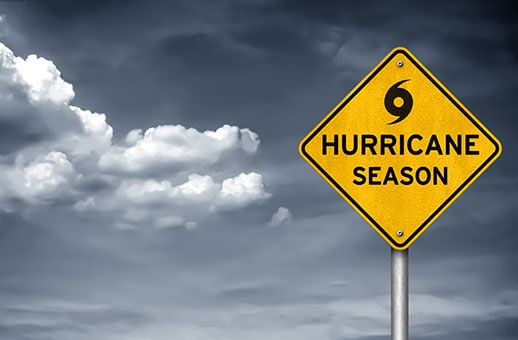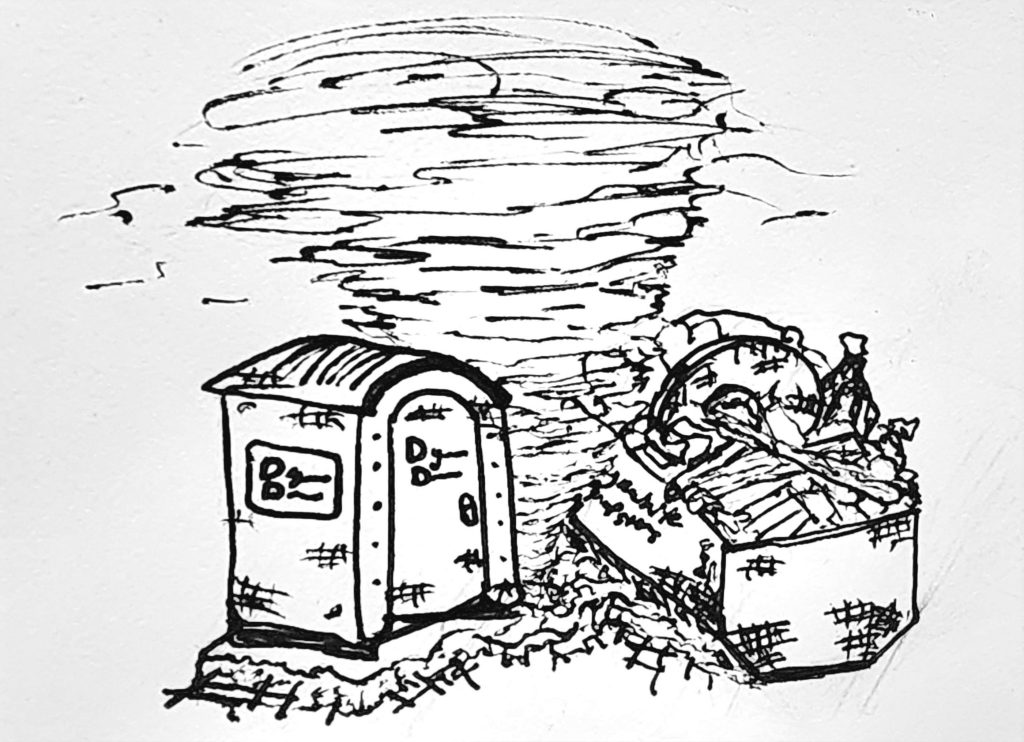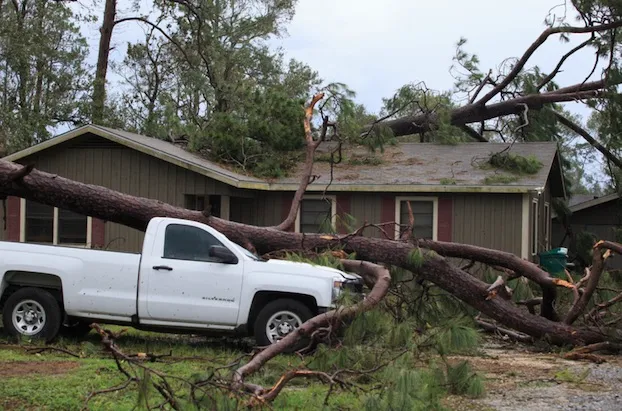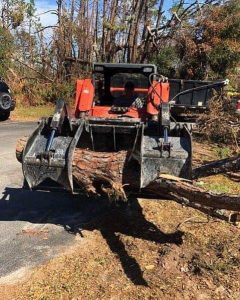
Disaster Relief – Hurricane Michael – October 2018
Ever since we’ve been in business, Dynamite Dumpsters has been there for all of our customers along the Gulf Coast during past hurricane seasons. Our team at Dynamite helps all affected people by providing the most durable and highest-quality dumpsters for the roughest cleanup sites. On top of dumpsters, we have also provided other products and will continue to provide them after disasters have struck. These include portable toilets, restroom trailers, dump trailers, skid steers, and clean-up crews to help assist. In the past, we have also included help with stump grinding. We have helped during the worst hurricanes and depressions, such as Laura, Ian, Delta, Michael, and, more recently, Ida.
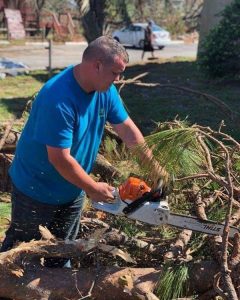
Jimmy Wilkinson aiding in disaster relief with the Dynamite Crew – Hurricane Michael – October 2018
Now, as the days are getting more humid and the end of summer is fast approaching, we wanted to share some not-so-commonly-seen hurricane tips that will help you save your property and wallet from costly disaster repairs. We all know that it can be a hassle when it comes to cleanup or refurbishment after a severe storm, hurricane, flood, or any other natural disaster. In each post, we will share with all of you different tips and tricks to help prevent yard and property damage and how to help keep an eye out for potential damage after oncoming storms or hurricanes have passed. And be sure to keep a lookout for a post-hurricane checklist from our Dynamite team who have shared some advice that most of us wouldn’t think of whenever scanning for damage after a strong storm.
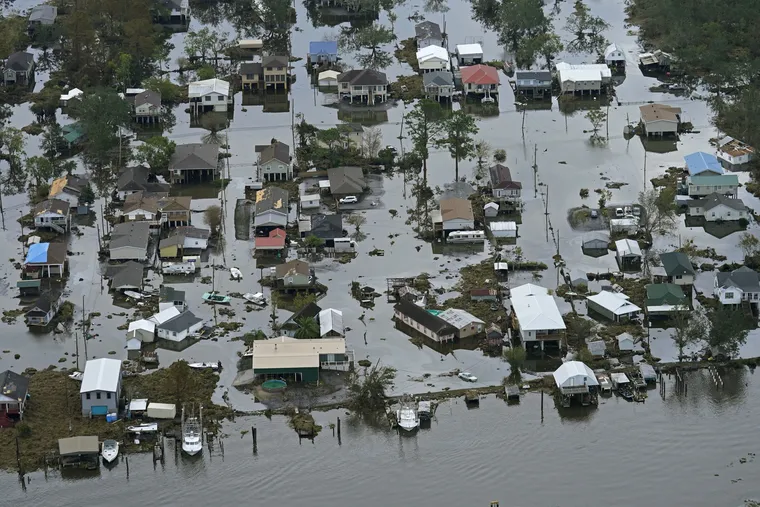
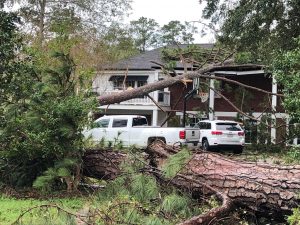
Home located next to Southeastern Louisiana University in a residential part of Hammond, Louisiana – Hurricane Ida – August 2021
During each major tropical storm or hurricane, most people are worried about running out of food, water, or power. Whatever happens to the outside of their house normally isn’t their first priority, which is understandable. However, the aftermath always finds a way to catch families by surprise whenever a gust of wind carries away their trampoline or a hail storm completely shatters their glass patio table. That is why we are here to share with you the most crucial and simplest tasks to help keep your home and property safe with you and your family this hurricane season.
Property Inspection Checklist (Post-Storm)
- Depending on the amount of damage that you are aware of, it might be best to keep small children and animals with a family friend or relative while you inspect the debris and property in case the terrain is rough or flooded.
- Normally, hurricanes and strong storms have the unfortunate chance of bringing in reptiles and rodents that wouldn’t normally hang around your house. This being said, be sure to keep an eye out for any snakes, rats, or potential alligators around your property and community that the flood waters may have brought in.
- Your sight isn’t the only sense that should be in high alert in these types of situations. Trust your nose and hearing too. If you start to hear a hissing sound and smell what seems like a type of gas, contact your fire department immediately.
- Before you go inside your home, be sure to check the exterior for any potential damage associated with power lines, gas lines, cracks in the foundation, or any other exterior factors that could pose a greater risk if you were to go inside.
- Open all doors and windows to give your home a chance to air out if the points of entry have been closed off for some time. This is especially important if you were not home during the storm and the house was closed up for longer than a 48 hour period. This is to help prevent a possible moisture buildup and mold growth from any water or moisture that may have entered your home during the time of the storm. You should still have a professional inspect your home for any signs of mold or bacteria buildup to be safe.
- If you chose to evacuate before the storm arrived, be sure to check in with family, friends, or neighbors in your area to see if the roads in and out are accessible for your drive back home. If you don’t know of anyone who stayed or anyone you could reach out to who would know, look to social media for answers such as Facebook, X (previously known as Twitter), and other branded platforms. Keep scrolling for an additional list of things you should check upon arriving back home if you’re able to.
- If you know that you live in a flood zone, check with your insurance provider and file a claim as soon as possible if your house suffered any flood damage after the disaster has hit. If you do not live in flood zone, you may have nothing to worry about; however, recall the flood of 2016 that impacted the greater portions of the southern states along the Gulf of Mexico? Most people who were no where near a flood zone were greatly impacted by this disaster and paid dearly for it since some didn’t have flood insurance.
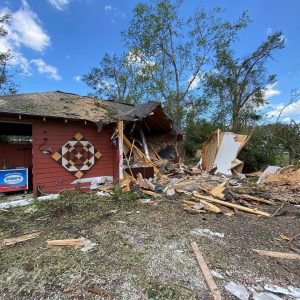
Local art business in Ponchatoula, Louisiana – Hurricane Ida – August 2021
While it’s nearly impossible to entirely prevent storm damage from hurricanes or strong thunderstorms, there are ways to minimize severe damage to your yard and property. Such storms often bring heavy rain, sleet, and strong winds. To protect your house, vehicle, and yard, take precautions like stowing away patio furniture and potted plants that could be caught by strong gusts. Position pots against walls, in corners, or even in your pool (referring to the patio furniture) to prevent them from being carried off by the wind.
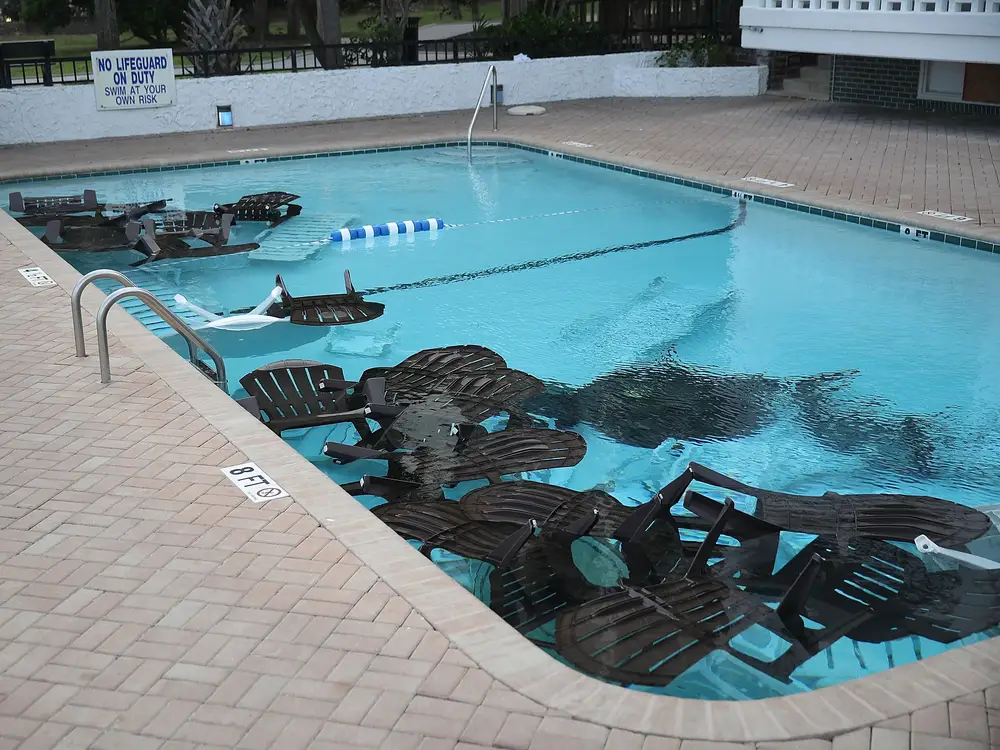
How to protect patio furniture in the early stages before the arrival of a hurricane or severe storm where heavy wind or flooding is expected.
Additionally, invert tables and chairs and reposition shelves to reduce their vulnerability to wind damage and potential harm to your property or your family. Making a designated hurricane check list for before, during, and after can help you and your family prepare for what’s to come if you plan on hunkering down during the storm. If you own any birdhouses, be sure they’re either taken down or moved indoors if applicable. We strongly recommend evacuating depending on the severity of the hurricane. If you’re living on the coast, be wary of tropical storms or depressions coming through. Keep an eye on the weather and on where and what any forming storms are up to.
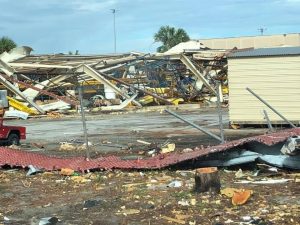
Debris of a business in Hammond, Louisiana – Hurricane Michael – November 2018
After a strong storm, we recommend conducting a thorough inspection of your property for any potential damage. Whether you find a few scattered limbs on the lawn or a massive branch on your car, knowing what to look for can make a significant difference. Start by checking your bushes, shrubs, trees, and lawn to assess any storm-related harm they might have incurred. Take note of any areas that received the most damage, including you have floodlights or other outdoor lighting. Investigate any fallen foliage or tree debris to trace their origins. Keeping track of these details can prove beneficial in preparing for future storms. If you discover that certain trees, branches, or hedges pose a risk to your house or vehicle due to their proximity, it’s crucial to take action. Consider trimming or removing any problematic trees, or possibly relocating hedges or shrubs on your property. Additionally, it’s wise to research which types of bushes and shrubs are best suited for your property. Some varieties might act as natural barriers against harsh storm winds, offering protection to your house. On the other hand, certain plants could easily uproot and end up in a different part of the yard. Being mindful of these factors will help you safeguard your property effectively. It’s very important to physically take note on your phone or writing down every incident that resulted in damage to your property. No matter how small it might seem, it could potentially help your claim.
Here are some areas of interest to physically check for damage that you can potentially file with your insurance claim depending on your current provider:
- window seals
- exterior siding
- roof and shingles
- damaged gutters
- water marks on ceiling
- door frames
- crown molding around floors and ceilings
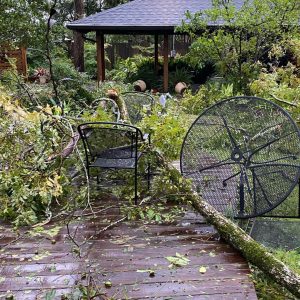
Home in Ponchatoula, Louisiana – Hurricane Ida – August 2021
- exterior lights
- outdoor fencing
- destruction of lawn ornaments, patio furniture, or plants (not all plants qualify, inquire about this with your insurance provider when submitting claim)
- trampolines
- outdoor playsets (check with your provider when filing a claim)
- detached garage or shed
- inground or above-ground pool
- expired refrigerated items
- vehicle damage
- water damage to furniture, electronics, etc.
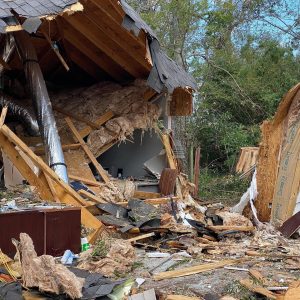
Destruction done to a local shop in Ponchatoula, Louisiana – Hurricane Ida – August 2021
If you need to file a claim with your insurance regarding the damage of your property or home, it’s important that you show them the list in detail of what all happened and what was harmed or damaged in the process. Be sure to read over your insurance’s policy on hurricane and storm damage to see what all needs to be verified and taken note of after a severe storm.
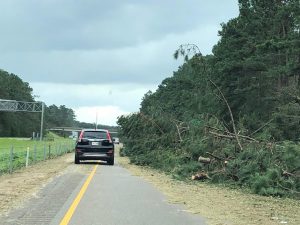
Fallen trees blocking parts of I-55 North between Hammond and Ponchatoula in Louisiana – Hurricane Ida – August 2021
We hope that this blog post will be helpful to you for any hurricanes or severe storms that come your way. Be sure to keep an eye out for the next blog post as we share more helpful tips and tricks down the line with all of you to help keep your yard and property prepped and prepared for whatever is to come and for after. There will be a future post that will feature more tips on what to look for when checking your yard and property after a strong storm or hurricane and give you a more detailed list of ways to prevent major yard damage before and after when renting our products in stormy situations. Have a safe and amazing year!
